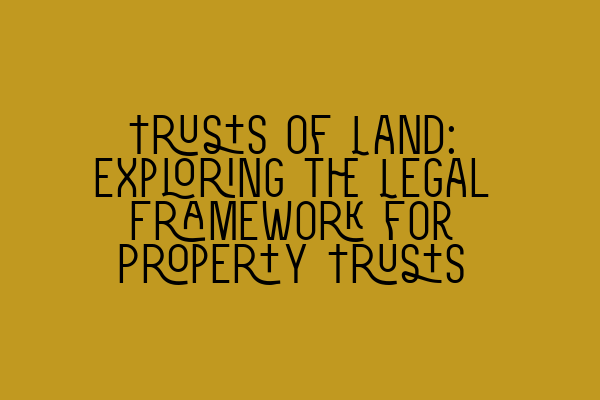Trusts of Land: Exploring the Legal Framework for Property Trusts
Welcome to another informative blog post brought to you by SQE Property Law & Land Law. In this article, we will be diving deep into the legal framework surrounding trusts of land, providing you with a comprehensive understanding of the subject.
But before we delve into the intricacies of property trusts, we invite you to check out some of our other engaging and educational content:
– [Interactive SQE Mock Tests for Contract Law: Test Your Knowledge](https://contract-law-sqe.co.uk/interactive-sqe-mock-tests-for-contract-law-test-your-knowledge/)
– [Join Our SQE Contract Law Webinars: Expert Insights and Guidance](https://contract-law-sqe.co.uk/join-our-sqe-contract-law-webinars-expert-insights-and-guidance/)
– [Contract Law Reforms: An Analysis of Recent Changes](https://contract-law-sqe.co.uk/contract-law-reforms-an-analysis-of-recent-changes/)
– [Parties in a Contract: Rights and Responsibilities](https://contract-law-sqe.co.uk/parties-in-a-contract-rights-and-responsibilities/)
– [The Importance of Ethics in Contract Law: A Comprehensive Guide](https://contract-law-sqe.co.uk/the-importance-of-ethics-in-contract-law-a-comprehensive-guide/)
Now, let’s dive into the world of property trusts and explore their legal foundation.
What are Trusts of Land?
Trusts of land refer to legal arrangements through which a person (known as the settlor) transfers the ownership of a property to a trustee, who holds it for the benefit of another person or group of people (known as beneficiaries). These types of trusts are governed by the Law of Property Act 1925 and provide a flexible means of managing and distributing property.
The Legal Framework
The legal framework for property trusts is primarily established by the Law of Property Act 1925, which sets out the rules and regulations governing the creation, administration, and termination of trusts of land. This Act, together with subsequent case law, forms the foundation for property trust matters in the UK.
Creation of a Property Trust
A property trust can be created through various means, such as a written trust deed, a declaration of trust, or even through the actions of the parties involved. It is crucial to ensure that the legal requirements for creating a trust, such as certainty of intention, subject matter, and beneficiaries, are fulfilled to ensure its validity.
Types of Property Trusts
Property trusts come in various forms, each serving different purposes and fulfilling different legal requirements. Some common types of property trusts include:
1. Bare Trusts: Also known as simple trusts, bare trusts provide the beneficiaries with an absolute right to the trust property. The trustee holds the property but has no discretion or control over how it is used.
2. Life Interest Trusts: In a life interest trust, the beneficiary (known as the life tenant) has the right to use and enjoy the property during their lifetime. After their death, the property passes to the remainderman, who is typically named in the trust deed.
3. Discretionary Trusts: Discretionary trusts provide the trustee with discretion over how the trust assets are distributed among the beneficiaries. This type of trust allows for flexibility in meeting the changing needs and circumstances of the beneficiaries.
Administration of Property Trusts
Once a property trust is created, it must be properly administered by the trustee. This involves managing the trust assets, ensuring compliance with legal obligations, and acting in the best interests of the beneficiaries. Trustees have a duty to act honestly, prudently, and in accordance with the terms of the trust.
Termination of Property Trusts
Property trusts can be terminated in several ways, including through the fulfillment of the trust’s purpose, expiration of the trust period, or by the agreement of all the beneficiaries. It is essential to follow the legal procedures for termination to ensure a smooth and lawful transition of the trust property.
Benefits and Considerations of Property Trusts
Property trusts offer several benefits, including:
– Estate planning: Property trusts can be used as a valuable tool for estate planning, allowing individuals to control how their assets are distributed and protecting their wealth for future generations.
– Asset protection: By transferring assets into a trust, individuals can effectively protect them from potential liabilities, such as creditors or divorcing spouses.
– Tax planning: Property trusts can also provide tax advantages, enabling individuals to minimize their tax liabilities and maximize their financial resources.
However, it is crucial to carefully consider the implications and obligations associated with property trusts. Seeking professional legal advice is strongly recommended to ensure compliance with the law and to meet the specific needs and objectives of the trust and its beneficiaries.
Conclusion
Trusts of land form a vital part of property law, providing a flexible and effective means of managing and distributing property. Understanding the legal framework surrounding property trusts is essential for individuals and professionals alike, ensuring compliance with the law and the achievement of their intended objectives.
We hope this article has shed light on the legal framework for property trusts and provided you with valuable insights into this complex area of law. For further guidance and expert advice, don’t hesitate to contact SQE Property Law & Land Law.
Don’t forget to explore our other informative articles on contract law and join our webinars for expert insights and guidance. Expand your knowledge and stay ahead in your legal career!
Disclaimer: This article is for informational purposes only and does not constitute legal advice. Consult a qualified solicitor for legal guidance specific to your situation.
